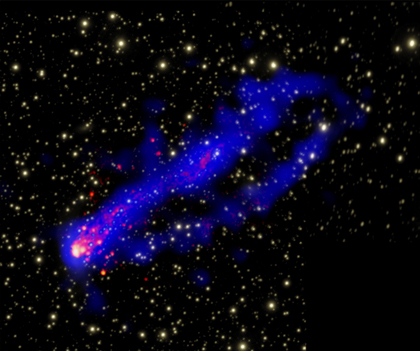For Release: January 21, 2010
MSU

Credit: X-ray: NASA/CXC/UVa/M. Sun, et al; H-alpha/Optical: SOAR (UVa/NOAO/UNC/CNPq-Brazil)/M.Sun et al.
Press Image and Caption
EAST LANSING, Mich. - "Crazy" and "cool" are two of the words Michigan State University astronomer Megan Donahue uses to describe the two distinct "tails" found on a long tail of gas that is believed to be forming stars where few stars have been formed before.
Donahue was part of an international team of astronomers that viewed the gas tail with a very long, new observation made by the Chandra X-ray Observatory and detailed it in a paper published this month in the publication Astrophysical Journal.
"The double tail is very cool - that is, interesting - and ridiculously hard to explain," said Donahue, a professor in MSU's Department of Physics and Astronomy. "It could be two different sources of gas or something to do with magnetic fields. We just don't know."
What is also unusual is the gas tail, which is more than 200,000 light years in length, extends well outside any galaxy. It is within objects such as this that new stars are formed, but usually within the confines of a galaxy.
"This system is really crazy because where we're seeing the star formation is well away from any galaxy," Donahue said. "Star formation happens primarily in the disks of galaxies. What we're seeing here is very unexpected."
This gas tail was originally spotted by astronomers three years ago using a multitude of telescopes, including NASA's Chandra X-ray Observatory and the SOuthern Astrophysical Research telescope, a Chilean-based observatory in which MSU is one of the partners. The new observations show a second tail, and a fellow galaxy, ESO 137-002, that also has a tail of hot X-ray-emitting gas.
How these newly formed stars came to be in this particular place remains a mystery as well. Astronomers theorize this gas tail might have "pulled" star-making material from nearby gases, creating what some have called "orphan stars."
"This system continues to surprise us as we get better observations of it," Donahue said.

